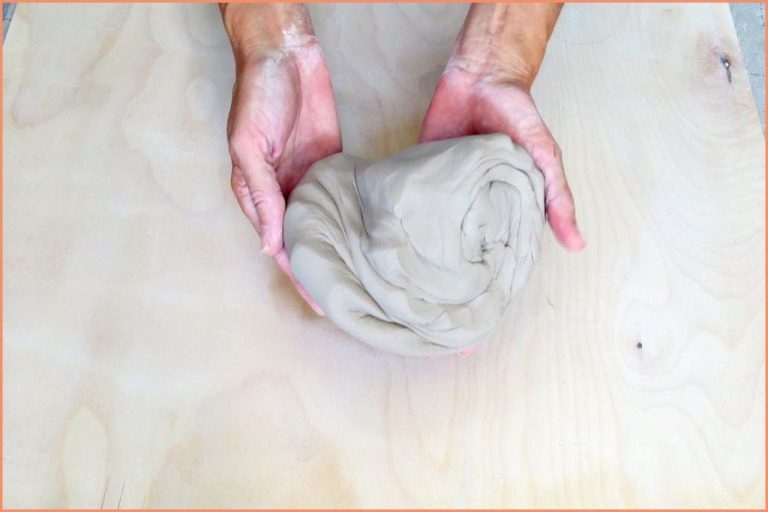What Does Vinegar Do To Clay?
Clay is a fine-grained natural material that can be molded and shaped when wet but hardens when dried or fired. Vinegar is a commonly used household liquid that contains acetic acid and has a sour taste. When vinegar is added to clay, it can produce chemical reactions that impact the clay in interesting ways. Specifically, vinegar can influence properties of the clay such as plasticity, hardness, and color. Understanding the interaction between these two substances is helpful for potters, ceramicists, and crafters who use clay in their work.
What is Clay?
Clay is a fine-grained natural material composed primarily of minerals like silica, alumina, and water. It is malleable when wet and rigid when fired at high temperatures. There are several types of clay that have different physical and chemical properties based on their mineral content.
The three main types of clay are:
- Kaolin – This white clay is ideal for making porcelain. It is derived from the mineral kaolinite and is very pure and plastic.
- Stoneware clay – This clay can be fired at high temperatures to make durable stoneware pottery. It is mined from underground deposits and commonly includes minerals like feldspar.
- Earthenware clay – This clay contains iron and other mineral impurities. It is used for making terra cotta pots and lower fired ceramics.
Clay is primarily used for making pottery, ceramics, and structural clay products. When mixed with water, clay becomes a moldable plastic material. Once shaped and fired in a kiln, the clay hardens permanently. The porosity and strength of the finished clay product depends on the mineral composition and firing temperature.
Properties of Clay
Clay is known for its unique properties that make it ideal for pottery, sculpture, and other applications. The key properties of clay include:
- Plasticity – Clay is highly plastic and can be molded into various shapes. The clay particles bond together when wet and retain the molded shape as they dry.
- Porosity – Clay has tiny pores that allow water to penetrate into the body. This gives clay its plasticity.
- Shrinkage – As clay dries, the water evaporates causing the clay body to shrink slightly. Each type of clay has a specific shrinkage rate.
- Hardness – The hardness of dried clay depends on the clay composition and firing temperature. Harder clays hold their shape better.
- Strength – Clay’s strength also depends on composition and firing. Higher firing temperatures result in stronger clay.
These unique properties allow clay to be shaped, dried, decorated, fired, and glazed into pottery, tiles, figurines, and more. The plasticity and workability make it a versatile material for artists and crafters.
What is Vinegar?
Vinegar is an acidic liquid that is commonly used as a cooking ingredient, food preservative, and cleaning product. The main ingredient in vinegar is acetic acid, which gives vinegar its sour taste and pungent smell.
Vinegar is produced through the fermentation of ethanol by acetic acid bacteria. There are different types of vinegar made from different source ingredients such as grapes, apples, rice, malt, coconut, and more. The most common types of vinegar include:
- Apple cider vinegar
- Balsamic vinegar
- White vinegar
- Red wine vinegar
- Rice vinegar
Vinegar has many culinary uses in salad dressings, marinades, food preservation, and pickling. It is also commonly used as a non-toxic household cleaner due to its antimicrobial and disinfectant properties. Vinegar can be diluted and applied to surfaces, windows, countertops and other areas to clean and disinfect.
Acidity of Vinegar
Vinegar is an acidic liquid that is commonly used in cooking, cleaning, and even DIY projects. The main ingredient in vinegar is acetic acid, which gives vinegar its acidic and sour taste.
The acetic acid concentration in vinegar can range anywhere from 4-8% typically. This gives most vinegars a pH between 2-3.5, making them highly acidic substances. For comparison, battery acid has a pH of around 1!
This high acidity is because the acetic acid in vinegar can readily dissociate in water into acetate ions and hydronium ions. The increase in hydronium ion (H3O+) concentration is what confers the low pH and sour taste.
Effects on Plasticity
Vinegar can have a significant effect on the plasticity and workability of clay. When vinegar is added to clay, it acts as a dispersant, breaking up clay particles and enabling them to move more freely against each other. This makes the clay more pliable, flexible, and plastic.
Vinegar allows clay particles to slide past each other more easily rather than sticking together rigidly. The increased spacing between clay particles from the vinegar allows the clay to bend and deform without cracking or breaking apart. This gives potters and ceramic artists greater ability to manipulate the clay into desired shapes and forms without needing excessive water content.
The acetic acid in vinegar is thought to interact with the charges on the flat surfaces of clay particles, reducing the forces of attraction between them. Less adhesion between particles translates to more freedom of movement and enhanced plasticity.
Potters often add small amounts of vinegar into clay to increase its workability and make it less likely to tear or crack when pulling up sides, stretching thinner sections, or bending clay into graceful curves. The right balance of vinegar can turn stiff, stubborn clay into a smooth, supple, and cooperative medium without needing to drastically alter its moisture level.
Effects on Hardness
The main effect that vinegar has on clay is that it can soften hardened clay. As clay dries, the clay particles bind together more tightly, causing the clay to become stiff and hard. Vinegar introduces acidity which breaks apart those connections between clay particles. The acidic vinegar molecules essentially wedge themselves between the bonded clay particles, pushing them apart gently. This allows the rigid clay to become malleable again.
By soaking hardened clay in a vinegar solution, the clay will begin to soften and can be worked with again. The vinegar allows the sculpture or structure to become flexible, so it can be reshaped as needed without cracking or breaking. This is useful for rehydrating clay pieces that have dried out, or for softening clay that has been overcooked and become too hard. The vinegar plasticizer allows the clay to regain its moldable texture.
The length of time needed for the vinegar to soften the clay depends on factors like how hardened the clay is initially, the clay composition, and the vinegar concentration. Generally though, a soak of a few hours up to overnight is sufficient to bring rigid clay back to a supple state. The end result is clay that has restored plasticity and can be molded and shaped as desired once again.
Effects on Color
One of the most noticeable effects of vinegar on clay is its ability to alter or fade the clay’s color. This is because vinegar is an acidic liquid. When clay is exposed to vinegar, the acidity can start to break down and react with the metal oxides and minerals that provide clay’s natural coloring.
For example, a red clay contains iron oxide, which gives it that rich, earthy red tone. But when vinegar is introduced, the acid begins to break down the iron oxide, causing the red pigment to fade and become pinkish or orange. The same goes for other color clays like yellows, browns, greens, etc. Each contains different metal oxides that the acetic acid in vinegar reacts with.
The duration of exposure impacts the degree of color change. A brief interaction with vinegar may only slightly alter the shade, whereas prolonged soaking can dramatically fade or mute the clay’s original color. The concentration of the vinegar solution also plays a role, with higher acidity leading to faster breakdown of the color pigments.
Many clays become paler or whiter after interacting with vinegar. While this may be undesirable if you want to maintain the original coloring, it does allow clays to be intentionally whitened or lightened using this vinegar technique.
Overall, vinegar’s acidity makes it a powerful agent for manipulating and transforming the inherent colors of clay bodies. Proper testing is advised to achieve the desired effect.
Other Effects
Vinegar can also have various other effects on clay besides just altering plasticity, hardness and color. Some key things to consider:
Porosity: The acid in vinegar can potentially increase the porosity of clay. As it reacts with the clay particles, it creates more spaces and pores within the clay structure. This can be good if you want the clay to dry faster and be more absorbent, but bad if you want an impermeable clay body.
Shrinkage: Increased porosity can also increase drying shrinkage and firing shrinkage. Because there are more pores for the water to escape from, the clay will shrink more as it dries. The increased porosity also means more shrinkage when fired. Carefully test shrinkage if using vinegar.
Structural integrity: Too much acid can start to break down the clay structure itself and make it weaker. Use vinegar in moderation to avoid compromising the structural integrity of the clay.
Firing: The vinegar residue can create defects like pinholes or scumming when fired if not properly washed out of the clay. Be sure to thoroughly rinse and dry clay treated with vinegar before firing.
Test small samples before commiting to using vinegar with a large amount of clay. Start with small amounts and increase gradually. The effects will also depend on the specific composition and mineral content of the clay body.
Using Vinegar with Clay
Vinegar can be used intentionally in clay projects to achieve certain effects. Here are some tips for incorporating vinegar:
-
Add a small amount of vinegar to clay when conditioning it to make it more pliable. The acidity softens the clay. Start with 1 teaspoon per 1 pound of clay and add more gradually if needed.
-
Create an antiqued or aged look. Brush white vinegar onto baked polymer clay. It will react with the clay and create a mottled, vintage effect.
-
Adjust the color. Vinegar can tone down or mute bright polymer clay colors. For a subtle shift, wipe the surface with a vinegar-dampened cloth.
-
Distress edges and surfaces. Use a Q-tip to apply vinegar just along seams or the edges of polymer clay pieces. It will rough up the texture for a worn, weathered appearance.
-
Add surface patterns. Let vinegar sit on polymer clay for several minutes to etch designs into the surface. Try using a resist like tape or silicone to create patterns.
-
Create faux patina. Spray or brush vinegar onto air-dry clay once it’s dried/cured to give it an aged, oxidized finish.
Start with small tests to see how vinegar reacts with your particular clay. Too much acidity can weaken clay structures. But used creatively in moderation, vinegar can provide some really interesting effects!


